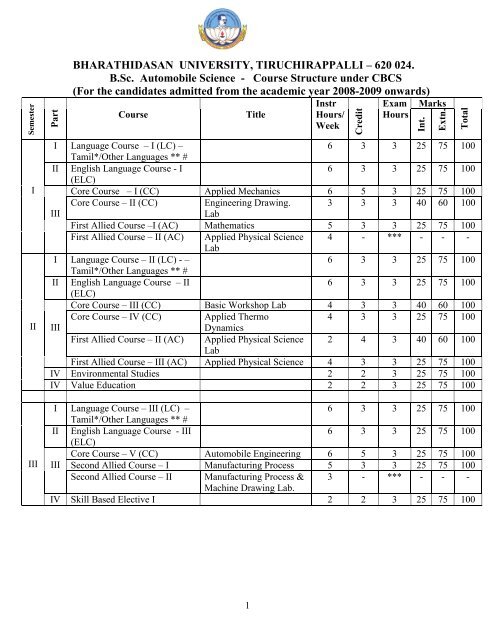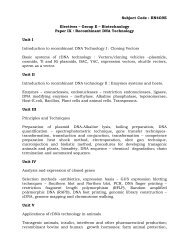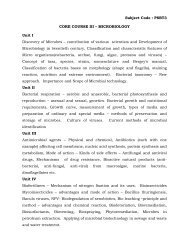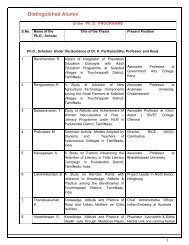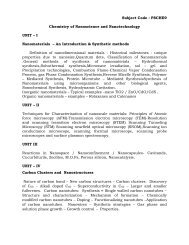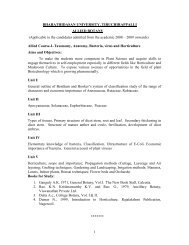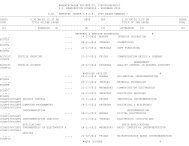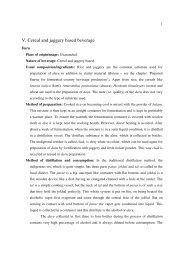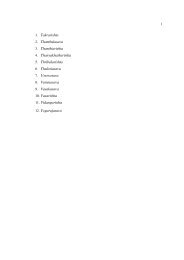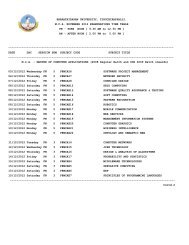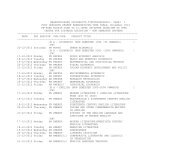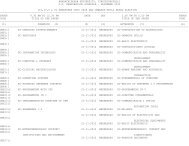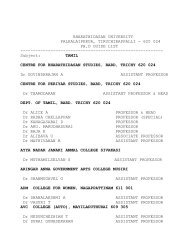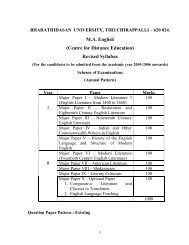Automobile Science - Bharathidasan University
Automobile Science - Bharathidasan University
Automobile Science - Bharathidasan University
You also want an ePaper? Increase the reach of your titles
YUMPU automatically turns print PDFs into web optimized ePapers that Google loves.
Semester<br />
I<br />
II<br />
III<br />
Part<br />
BHARATHIDASAN UNIVERSITY, TIRUCHIRAPPALLI – 620 024.<br />
B.Sc. <strong>Automobile</strong> <strong>Science</strong> - Course Structure under CBCS<br />
(For the candidates admitted from the academic year 2008-2009 onwards)<br />
Course<br />
Title<br />
1<br />
Instr<br />
Hours/<br />
Week<br />
Credit<br />
Exam<br />
Hours<br />
Marks<br />
I Language Course – I (LC) –<br />
Tamil*/Other Languages ** #<br />
6 3 3 25 75 100<br />
II English Language Course - I<br />
(ELC)<br />
6 3 3 25 75 100<br />
Core Course – I (CC) Applied Mechanics 6 5 3 25 75 100<br />
Core Course – II (CC) Engineering Drawing. 3 3 3 40 60 100<br />
III<br />
Lab<br />
First Allied Course –I (AC) Mathematics 5 3 3 25 75 100<br />
First Allied Course – II (AC) Applied Physical <strong>Science</strong><br />
Lab<br />
4 - *** - - -<br />
I Language Course – II (LC) - –<br />
Tamil*/Other Languages ** #<br />
6 3 3 25 75 100<br />
II English Language Course – II<br />
(ELC)<br />
6 3 3 25 75 100<br />
Core Course – III (CC) Basic Workshop Lab 4 3 3 40 60 100<br />
Core Course – IV (CC) Applied Thermo<br />
4 3 3 25 75 100<br />
III<br />
Dynamics<br />
First Allied Course – II (AC) Applied Physical <strong>Science</strong><br />
Lab<br />
2 4 3 40 60 100<br />
First Allied Course – III (AC) Applied Physical <strong>Science</strong> 4 3 3 25 75 100<br />
IV Environmental Studies 2 2 3 25 75 100<br />
IV Value Education 2 2 3 25 75 100<br />
I Language Course – III (LC) –<br />
Tamil*/Other Languages ** #<br />
6 3 3 25 75 100<br />
II English Language Course - III<br />
(ELC)<br />
6 3 3 25 75 100<br />
Core Course – V (CC) <strong>Automobile</strong> Engineering 6 5 3 25 75 100<br />
III Second Allied Course – I Manufacturing Process 5 3 3 25 75 100<br />
Second Allied Course – II Manufacturing Process &<br />
Machine Drawing Lab.<br />
3 - *** - - -<br />
IV Skill Based Elective I 2 2 3 25 75 100<br />
Int.<br />
Extn.<br />
Total
IV<br />
V<br />
VI<br />
Non Major Elective I - for<br />
those who studied Tamil under<br />
Part I<br />
a) Basic Tamil for other<br />
language students<br />
b) Special Tamil for those who<br />
studied Tamil upto +2 but opt<br />
for other languages in degree<br />
programme<br />
I Language Course –IV (LC) -<br />
Tamil*/Other Languages ** #<br />
II English Language Course – IV<br />
(ELC)<br />
Basic Concepts of 4<br />
wheeled <strong>Automobile</strong>s<br />
2<br />
2 2 3 25 75 100<br />
6 3 3 25 75 100<br />
6 3 3 25 75 100<br />
Core Course – VI (CC) <strong>Automobile</strong>s Engine<br />
Components Lab.<br />
4 3 3 40 60 100<br />
III Core Course – VII (CC) Mechanics of Materials 3 3 3 25 75 100<br />
Second Allied Course - II Manufacturing Process &<br />
Machine Drawing Lab.<br />
4 4 3 40 60 100<br />
Second Allied Course - III CAD/CAM 3 3 3 25 75 100<br />
IV Non Major Elective II - for Basic Concepts of 2 & 3 2 2 3 25 75 100<br />
those who studied Tamil under<br />
Part I<br />
a) Basic Tamil for other<br />
language students<br />
b) Special Tamil for those who<br />
studied Tamil upto +2 but opt<br />
for other languages in degree<br />
programme<br />
wheeled <strong>Automobile</strong>s<br />
IV Skill Based Elective II 2 2 3 25 75 100<br />
Core Course – VIII (CC) <strong>Automobile</strong> <strong>Science</strong> Lab. 5 5 3 40 60 100<br />
Core Course – IX (CC) <strong>Automobile</strong> Chassis<br />
System<br />
5 5 3 25 75 100<br />
III Core Course – X (CC) <strong>Automobile</strong> Electrical &<br />
Electronics<br />
6 5 3 25 75 100<br />
Core Course – XI (CC) Autotronics & Vehicle<br />
Maintenance<br />
5 5 3 25 75 100<br />
Major based Elective – I <strong>Automobile</strong>s Body<br />
Structures<br />
5 5 3 25 75 100<br />
Skill based Elective –III 2 2 3 25 75 100<br />
IV Skill based Elective – IV 2 2 3 25 75 100<br />
Core Course – XII(CC) Automotive chassis<br />
components Lab.<br />
5 5 3 40 60 100<br />
Core Course – XIII (CC) Basics of Body Building 5 5 3 25 75 100<br />
III Core Course – XIV (CC) <strong>Automobile</strong> Transmission 6 5 3 25 75 100<br />
Major based Elective II Alternative fuels &<br />
Energy sources<br />
5 5 3 25 75 100
Major based Elective III Vehicle steering &<br />
Braking system<br />
5 5 3 25 75 100<br />
IV Skill Based Elective – V 2 2 3 25 75 100<br />
Skill Based Elective - VI 2 2 3 25 75 100<br />
V Extension activities - 1 - - - -<br />
Total 180 140 400<br />
0<br />
Note:<br />
Internal Marks External Marks<br />
1. Theory 25 75<br />
2. Practical 40 60<br />
3. Separate passing minimum is prescribed for Internal and External marks<br />
The passing minimum for CIA shall be 40% out of 25 marks [i.e. 10 marks]<br />
The passing minimum for <strong>University</strong> Examinations shall be 40% out of 75 marks [ i.e. 30<br />
marks]<br />
* for those who studied Tamil upto +2 (Regular Stream)<br />
** Syllabus for other Languages should be on par with Tamil at Degree<br />
level<br />
# those who studied Tamil upto 10 th or +2, but opt for other languages in<br />
degree level under Part I should study special Tamil in Part IV<br />
*** Examination at the end of the next semester.<br />
Extension activities shall be out side the instruction hours.<br />
Fw;gpf;F Fw;gpf;Fk; Fw;gpf;F Fw;gpf;Fk;<br />
k; fhy msT<br />
Nkhopg; ghlq;fs; - 1 kjpg;gPL = 2 kzpNeuk; fw;gpj;jy; tFg;G<br />
Fiy kw;Wk; mwptpay; ghlq;fs; :1 kjpg;gPL = 1 kzpNeuk; fw;gpj;jy; tFg;G<br />
[Lecture]<br />
= 2 kzpNeuk; gapw;rp tFg;G<br />
[Tutorial]<br />
= 2-3 kzpNeuk; nra;Kiw tFg;G<br />
[Practical]<br />
Eligibility criteria<br />
3
A pass in the HSC (Academic) or its equivalent with the minimum average<br />
percentage in the relevant subjects as prescribed :<br />
OR<br />
A pass in any one the following HSC (Vocational Stream) with Engineering /<br />
Technology Vocational subjects and any ONE or Two of the related subjects like<br />
Mathematics, Physics or Chemistry with minimum average percentage in the relevant<br />
subjects as prescribed below:<br />
Vocational subjects prescribed for B.Sc. <strong>Automobile</strong> <strong>Science</strong> Degree admission<br />
Sl.No. Name of the Vocation Course<br />
1. Auto Mechanic<br />
2. Building Maintenance<br />
3. Business Machines and Computer Programming<br />
4. Diesel Mechanic<br />
5. Domestic Electonic Equipment (Project Equipment)<br />
6. Draughtsman (Civil)<br />
7. Draughtsman (Mechanical)<br />
8. Electrical Domestic Appliance, repairs and maintenance<br />
9. Electrical Motor Rewinding<br />
10. Farm Machines and Post Harvest Technology<br />
11. Fitting<br />
12. Foundry<br />
13. General Machinist<br />
14. Leather Technology<br />
15. Maintenance and Servicing of Electrical Machines including<br />
generators<br />
16. Metal Finishing<br />
17. Radio and Television (Maintenance and repair)<br />
18. Repair and Maintenance of Refrigeration and Air conditioning<br />
Equipments<br />
19. Repair and Maintenance of Two Wheelers<br />
20. Sheet metal works<br />
21. Soil Conservation and Rural Construction Technology<br />
22. Textile Technology<br />
23. Tractor repair and maintenance<br />
24. Welding<br />
OR<br />
A pass in one of the following Diploma in Engineering / Technology of the State<br />
Board of Technical Education and Training, Tamilnadu with minimum average<br />
Percentage of marks in the semester examinations as prescribed below:<br />
Sl.No. Name of the Branch in Diploma<br />
1. Agricultural Engineering<br />
4
2. Agricultural Engineering and Farm Equipment Technology<br />
3. Architectural Assistantship<br />
4. <strong>Automobile</strong> Engineering<br />
5. Ceramic Technology<br />
6. Chemical Technology<br />
7. Civil and Rural Engineering<br />
8. Civil Engineering<br />
9. Computer <strong>Science</strong> and Engineering<br />
10. Computer Technology<br />
11. Electrical and Electronics Engineering<br />
12. Electronics (with specialization in Instrumentation)<br />
13. Electrical and Communication Engineering<br />
14. Fisheries Technology<br />
15. Foundry Technology<br />
16. Instrument Technology<br />
17. Machine Design and Drafting<br />
18. Machine Tool Maintenance and Repair<br />
19. Man Made Fibre Technology<br />
20. Mechanical and Rural Engineering<br />
21. Mechanical Engineering<br />
22. Metallurgy<br />
23. Paper and Pulp Technology<br />
24. Petro – Chemical Technology<br />
25. Polymer Technology<br />
26. Production Engineering<br />
27. Prosthetics and Orthetics<br />
28. Refrigeration and Air Conditioning<br />
29. Textile Designing and Weaving<br />
30. Textile Engineering<br />
31. Textile Manufacture (Sand Wich)<br />
32. Textile Marketing and Management<br />
33. Textile Processing<br />
34. Textile Technology<br />
35. Tool Engineering<br />
OR<br />
Any other equivalent qualification for the Degree of B.Sc. <strong>Automobile</strong> <strong>Science</strong><br />
programme admissions approved by the State Board of Technical Education and<br />
Training, Tamilnadu / Higher Secondary Board of Tamilnadu / <strong>Bharathidasan</strong> <strong>University</strong>.<br />
Semester – I<br />
5
Core Course- I (CC) - APPLIED MECHANICS<br />
UNIT- I STATICS OF PARTICLES<br />
Concept of particle and rigid bodies – Composition of concurrent forces in plane and<br />
space-problems involving the equilibrium of a particle – free body diagram; Equilibrium<br />
of a particle in space – simple problems.<br />
UNIT-II FRICTION<br />
Laws of friction – Coefficient of friction, problems involving dry friction – wedge,<br />
ladder, screw (simple) and belt friction (open belt drive only) – Analysis of simple place<br />
trusses by method of joints and method of sections.<br />
UNIT-III CENTROIDS, CENTRE OF GRAVITY AND MOMENT OF<br />
INERTIA<br />
Centroids of lines, areas and masses; composite areas – determination of moment of<br />
inertia of place figures; polar moment of inertia, radius of gyration – mass moment of<br />
inertia of rectangular and triangular plates and of cylinder.<br />
UNIT-IV KINEMATICS OF PARTICLES<br />
Introduction – Degrees of freedom; rectilinear motion; curvilinear motion (Plane) –<br />
rectangular coordinates; projectile – normal and tangential components, relative motion –<br />
concept and simple problems<br />
UNIT-V IMPULSE AND MOMENTUM<br />
Work energy method – Potential energy – kinetic energy – Conservation of energy –<br />
simple problems – Impulse – Momentum Principle<br />
TEXT BOOK<br />
1. “Engineering Mechanics”, Kumar, K.L., Tata Mc Graw Hill.<br />
REFERENCE<br />
1. “Vector Mechanics for Engineers – Statics and Dynamics”, Beer, F.P. and<br />
Johnson, E.R., Mc Graw Hill International Book Co.,<br />
CORE COURSE – II (CC)<br />
6
ENGINEERING DRAWING<br />
UNIT -1 INTRODUCTION, PROJECTION OF POINTS AND LINES<br />
Use of drawing instruments – BIS Convention and specifications-size, layout lettering<br />
and dimensioning practice. Special curves-Ellipse – parabola Hyperbola involutes.<br />
Introduction to orthographic projections – projection of points-projection of straight lines<br />
in the first quadrant-line is parallel to both planes-inclined to one plane and parallel to<br />
other – inclined to both the planes.<br />
UNIT –II PROJE CTION OF PLANES AND SOLIDS<br />
Projection of planes like polygonal lamina and circular lamina. Projection of simple<br />
solids like cube, prism, pyramid, cylinder, cone. Auxiliary projections.<br />
UNIT – III SECTION OF SOILDS AND ORTHOGRAPHIC PROJECTION<br />
Section of solids like Prism, Pyramid, cylinder, cone in simple positions true shape and<br />
section for above. Convention of pictorial views to orthographic view of simple machine<br />
members.<br />
UNIT – IV INTERSECTION OF SOLIDS AND DEVELOPMENT OF<br />
SURFACES<br />
Intersection of solids-prism to prism-cylinder to cylinder-cone to cylinder.Development<br />
of surface-development of surface of solids-prism, pyramid, cylinder, cone and cut solids.<br />
UNIT –V ISOMETRIC PROJECTION AND PERSPECTIVE<br />
PROJECTION<br />
Isometric Projection of simple solids like prism, pyramid, cylinder, cone and cut solids.<br />
Perspective projection-visual ray method-vanishing point method-point, straight line,<br />
lamina, prism, pyramid.<br />
TEXT BOOK<br />
1. K.V. Natarajan A text book of Engineering Drawing, Dhanalakhmi Publication,<br />
Chennai<br />
REFERENCE<br />
1. N.D. Bhatt., Engineering Drawing, Charotar book stall, Anand<br />
FIRST ALLIED COURSE-I (AC)<br />
7
UNIT – I MATRICES<br />
MATHEMATICS<br />
The characteristic equation, eigen values and eigen vectors of a real matrix, some<br />
properties of eigen values, Cayley – Hamiltonian theorem, reduction of a real matrix to a<br />
diagonal form, orthogonal matrices – properties, reduction of a quadratic form to<br />
canonical form by orthogonal transformation.<br />
UNIT – II GEOMETRICAL APPLICATIONS OF DIFFERENTIAL<br />
CALCULUS<br />
Curvature – Cartesian and polar co-ordinates, circle of curvature, involutes and evolutes,<br />
envelopes, properties of envelopes, envelopes of normal to a curve.<br />
UNIT – III FUNCTIONS OF SEVERAL VARIABLES<br />
Total differential derivative of implicit functions, partial derivative of a Function of two<br />
functions, Taylor’s expansion for a function of two variables, maxima and minima,<br />
jacobians, differentiation under the integral sign.<br />
UNIT – IV DIFFERENTIAL EQUATIONS;<br />
First order equations – variables separable – Homogeneous equations – Exact equations –<br />
integrating factors – Linear equation – Reduction of order.<br />
UNIT – V DIFFERENTIAL EQUATIONS<br />
Simultaneous linear equations with constant coefficients, homogeneous linear equations<br />
of Euler type, equation reducible to homogenous form, linear equations of second order<br />
with variable coefficients, Method of reduction of order, transformation of the equation<br />
by changing the dependent variable, method of variation of parameters.<br />
TEXT BOOK<br />
1. Venkataraman, M.K. “Engineering Mathematics” – First year – national<br />
publishing company, Chennai – 1998.<br />
REFERENCE<br />
1. Veerarajan, T, “Engineering Mathematics”. Tata McGraw Hill Publishing Co.,<br />
New Delhi, 1999.<br />
8
LIST OF EXPERIMENTS:<br />
FIRST ALLIED COURSE - II (AC)<br />
APPLIED PHYSICAL SCIENCES LAB<br />
1. Torsional Pendulum – Rigidity modulus of a wire<br />
2. Thickness of Thin Films (Fizzaeu’s fringes)<br />
3. Spectrometer grating and Hg spectrum<br />
4. Carey – Foster’s bridge – Resistance calculation<br />
5. Laser Grating<br />
6. Moment of Inertia of Circular Disc<br />
7. Newton’s Rings – Radius of Curvature of lens<br />
8. Carey – Foster’s bridge – Temperature coefficient of resistance of a coil<br />
9. EMF of a Thermo couple<br />
10. Fiber optics experiments<br />
CARPENTY<br />
Semester – II<br />
Core Course – III (CC) - BASIC WORKSHOP LAB<br />
Tools and Equipments-Planning Practice-making Tee Halving Joint-Dove Tail joint-Lap<br />
Joint-Mortise and Tennon Joint<br />
FITTING<br />
Tools and Equipments-Practice in Chipping, Filling-making vee joints, square and dove<br />
tail joints<br />
SHEET METAL<br />
Tools and Equipments-Fabrication of tray, cone, etc., with sheet metal<br />
FOUNDRY<br />
Tools and Equipments- Preparation of moulds of simple objects like flange, gear,vgrooved<br />
pulley etc.<br />
SMITHY<br />
Tools and Equipments-Demonstration for making simple parts like keys, bolts etc<br />
9
REFERENCES:<br />
1. V.S. Venkatachalapathy., “First year Engineering Practice”, Raamalinga Publications,<br />
Madurai.<br />
2. P.Kanaiah, K.C.Narayana., “Manual on Workshop Practice”, Scitech Publications”,<br />
Chennai.<br />
CORE COURSE - IV (CC) - APPLIED THERMO DYNAMICS<br />
UNIT – I FIRST LAW OF THERMODYNAMICS<br />
System, thermodynamic equilibrium, state, property, process, cycle, zeroth law of<br />
thermodynamics, energy, work, heat, first law of thermodynamics, PMM I, application<br />
of first law of thermodynamics to closed and open systems, pressure – volume diagrams,<br />
steady flow process, application of steady flow energy equation.<br />
UNIT – II SECOND LAW OF THERMODYNAMICS<br />
Limitations to the first law- heat engine and reversed heat engines- Kelvin Plank and<br />
Clausius Statements-reversibility-corollaries- Carnot cycle-thermodynamic temperature<br />
scale-entropy-Clausius inequality – PMM II<br />
UNIT – III GAS AND VAPOURS<br />
Mixture of gas and vapour-Dalton’s Law of partial pressures-properties of water and air-<br />
vapour mixtures-psychometric chart-psychometric calculations.<br />
UNIT – IV RECIPROCATING AIR COMPRESSORS<br />
Single acting and double acting air compressors, work required effect of clearance<br />
volume, volumetric efficiency, isothermal efficiency, free air delivery, multistage<br />
compression, and condition for minimum work.<br />
UNIT-V FUNDAMENTALS OF REFRIGERATION AND<br />
REFRIGERATION CYCLES<br />
Fundamentals of refrigeration, C.O.P., reversed carnot cycle, simple vapour compression<br />
refrigeration system, T-S, P-H diagrams, simple vapour absorption refrigeration system,<br />
desirable properties of an ideal refrigerant.<br />
TEXTBOOK<br />
1. P.K.Nag- Engineering Thermodynamics, Tata McGraw Hill Publishing Company Ltd,<br />
New Delhi,2002<br />
10
REFERENCES<br />
1. C.P.Gothandaraman- Engineering Thermodynamics, Danpatra Publications, New<br />
delhi.<br />
2. P.L.Ballany- Thermal Engineering, Khanna Publishers, New Delhi<br />
3. R.S.Khurmi, J.K.Gupta - A textbook of thermal Engineering- S.Chand & company<br />
Ltd- 2003.<br />
List of Experiments<br />
FIRST ALLIED COURSE - II (AC)<br />
APPLIED PHYSICAL SCIENCES LAB<br />
1. Estimation of Fe 2+ using dichrometry and disphenylamine indicator<br />
2. Estimation of CI by Mohr’s method using potassium chromate indicator<br />
3. Extimation of Fe 2+ by potentiometric titration<br />
4. Estimation of available chlorine in bleaching powder<br />
5. Critical Solution Temperature – Phenol water system<br />
6. Estimation of copper by iodometry<br />
FIRST ALLIED COURSE - III (AC)<br />
APPLIED PHYSICAL SCIENCE<br />
UNIT-I PROPERTIES OF MATTER<br />
Elasticity: Definitions of linear stress and linear strain - statement of Hooke’s law -<br />
definitions of young ‘s modulus, Bulk modulus and rigidity modulus .Viscosity:<br />
Definitions of streamline and turbulent motion. Definition of coefficient of viscosity -<br />
experimental comparison of viscosities of two liquids Surface Tension:Definitions of<br />
surface Tension and angle of contact. Derivation of the formula for surface tension of a<br />
liquid by capillary rise method.<br />
UNIT-II LASER, FIBRE OPTICS AND SOUND<br />
Principles of Laser-Laser characteristics – Ruby – NDYAG, HE-Ne, CO2, and<br />
semiconductor lasers-Types of optical fibres, applications of optical fibres-Optical wave<br />
guides and sensors. Definitions of longitudinal waves, transverse waves, progressive<br />
waves, stationary waves, wave length- frequency and velocity - experiment of determine<br />
the frequency of a tuning fork. Accoustics of buildings - reverberation - reverberation -<br />
time - echo coefficient of absorption of sound energy.<br />
11
UNIT-III HIGH POLYMERS AND ELECTROCHEMICAL CELLS<br />
Types of polymerization – Addition, Condensation polymerization – Classification of<br />
high polymers – Plastics – Properties of polymers– Natural and synthetic rubber–<br />
conducting polymers. Galvanic cells, Single electrode potentials, Standard electrode<br />
potentials, Electromotive force, Electromotive series, Measurement of EMF of a cell,<br />
Reference electrodes – Hydrogen, Calomel and Glass electrodes, Batteries – Primary and<br />
secondary cells, Lead acid storage cell.<br />
UNIT-IV FUELS AND COMBUSTION<br />
Varieties of coal – Coke manufacture – Hydrogenation of coal – Liquid fuel production<br />
by cracking methods – Production of producer and water gas – LPG – Natural Gas –<br />
Biogas.Combustion of fuel – Spontaneous ignition temperature – Explosive range –<br />
Calorific values Calculation of calorific value using Dulong’s method – Calculation of air<br />
quantities for complete combustion of fuel.<br />
UNIT-V CORROSION AND METALLIC COATINGS.<br />
Types of corrosion: Dry or chemical Corrosion, Wet or electrochemical corrosion,<br />
Galvanic corrosion – Different types of corrosion: General or uniform corrosion, Fitting<br />
corrosion, water one corrosion, Stress corrosion – Prevention of corrosion.Anodic and<br />
cathodic coatings – Hot dipping – Cladding – Cementation process – Electroplating –<br />
Immersion plating – Chemical conversion coating – Anodizing.<br />
TEXT BOOKS<br />
1. Applied physics for engineers,2 nd edn, V.Rajendran, M.Marikani,Tata McGraw Hill<br />
2. “Engineering Chemistry” Jain and Jain, Dhanpat Rai Publishing company, New<br />
Delhi, 1999.<br />
REFERENCES:<br />
1. Fiber optics, John Gower, Prentice Hall of India New Delhi, 1954.<br />
“Chemistry in Engineering & Technology”, Vol I and II, J.C. Kuriacose & J. Rajaraman,<br />
Tata McGraw Hill.<br />
12
Semester - III<br />
CORE COURSE – V (CC) - AUTOMOBILE ENGINEERING<br />
UNIT – I PETROL ENGINES<br />
Petrol Engines - Working principle of two stroke and four stroke engines -comparison -<br />
main bearings connecting rod - bearings - major parts of an engine - engine block,<br />
Cylinder head, Liner, Piston, crank shaft, cam shaft - Types of engines, Straight V.Square<br />
engine - combustion chamber deign - types – valves- static balance and dynamic balance<br />
- analysis of performance of single and multi cylinder engines - Firing order - Detonation<br />
/ Petrol knock - Octane number.<br />
UNIT II PETROL FUEL FEED SYSTEMS & CARBURETORS<br />
Fuel feed system — layout —construction and working of mechanical and Electrical fuel<br />
feed pumps- Fuel filters- Air filter, types - carburetion — principles — simple<br />
carburetors — drawbacks of simple carburetors — compensating system — carburetor<br />
circuit —Solex carburetor — S.U Carburetor, Mikuni carburetor, Inlet and Exhaust<br />
manifolds- Mufflers and silencers.<br />
UNIT III COOLING & LUBRICATION SYSTEM<br />
Cooling system - Air cooling system, water cooling system - Comparison - types —<br />
thermostat —types and construction— water pump - Radiators — types - constructional<br />
details — Lubrication system — types — Characteristics of lubricating oils-classification<br />
and identification of SAE oils – Filters - oil pumps - type - construction and operation -<br />
Pressure Relief valve — oil pressure gauge Bourdon type — positive crank case<br />
ventilation system - construction draft tube - coolent type cooling system - vapour<br />
cooling system.<br />
UNIT IV DIESEL ENGINES & DIESEL FUEL FEED SYSTEM<br />
High Speed Diesel Engines - Two stroke and four strokes - combustion of Diesel fuel,<br />
phase of combustion in four stroke engines - diesel knock, Cetane number fuel dopes -<br />
Types of Diesel engine combustion chamber— Piston crown design for diesel engines .<br />
Diesel fuel system - Layout - Feed pump single and double acting - Fuel injection pump,<br />
jerk and distributor type — construction and operation — Diesel filters — Pre filter and<br />
Micro filter — water separator —Injectors and nozzles — Open type and closed type,<br />
single hole and multi hole, pintle and pintaux type nozzles.<br />
UNIT V GOVERNORS, SUPER CHARGERS AND EMISSION CONTROLS<br />
Governors - Mechanical and pneumatic type - Phasing and Calibration of fuel injection<br />
pumps — Injection timing — Testing of Injectors .Super charging — Its effect — Types<br />
13
of super chargers — roots type sliding vane and centralized types of Turbo chargers.<br />
Emission control in petrol and diesel engines — catalytic converters- un leaded petrol —<br />
petrol engine tune - up maintenance - Engine analysis of gas emission - working principle<br />
of gas analyzer.<br />
TEXT BOOK<br />
1.Ganesan,V., Internal Combustion Engines,Tata McGraw Hill Co., 1994<br />
REFERENCES<br />
1. Heywood.J.B.,Internal Combustion Engines Fundamentals,McGraw Hill Book<br />
Co.,1995<br />
2. <strong>Automobile</strong> Engines - William H.Grouse<br />
3. Ramalingam. K.K ,Internal Combustion Engines, SciTech<br />
Publications,Chennai,2003<br />
SECOND ALLIED COURSE – I (AC)<br />
MANUFACTURING PROCESS<br />
UNIT - I FORGING AND POWDER METALLURGY<br />
Hot working - advantages of hot working -hot working operations - rolling - forging<br />
hammer or smith forging drop forging, upset forging, press forging - roll forging.<br />
Methods of manufacturing metal powders - atomization reduction of oxides and<br />
electrolytic deposition —pressing operation — sintering — hot pressing — sizing —<br />
infiltration — mechanical properties of parts made by powder metallurgy — design rules<br />
for the powder metallurgy process.<br />
UNIT - II HEAT TREATMENT OF METALS<br />
Heat treatment processes — purpose —procedures — application of various heat<br />
treatment processes — iron carbon equilibrium diagram —full annealing — process<br />
annealing — stress relief annealing — spherodising annealing — isothermal annealing —<br />
normalizing - hardening - tempering - quenching medium - different types and their<br />
relative merits —case hardening — pack carbursing — cyaniding — nitriding —<br />
induction hardening and flame hardening.<br />
UNIT III METROLOGY, PRESS WORKING AND NON-CONVENTIONAL<br />
MACHINING PROCESS METROLOGY:<br />
Metrology concepts — Measuring instruments —comparators — mechanical, electrical,<br />
optical and pneumatic comparators —profile measurements - optical flat — surface finish<br />
measurements — profilometers. Types of presses — mechanical and hydraulic presses —<br />
press tools and accessories- press working operations - Ultrasonic machining — chemical<br />
14
machining —electro chemical grinding — electrical discharge machining — plasma arc<br />
machining — laser machining.<br />
UNIT - IV LATHE AND THEORY OF METAL CUTTING<br />
Types of lathes — specifications — simple sketches — principal parts — head stock —<br />
back geared types — all geared type - tumbler gear mechanism quick change gear box —<br />
apron mechanism —carriage cross slide — automatic, longitudinal - and cross feed<br />
mechanism —tail stock and its function —work holding services —face plate —three<br />
jaw chuck —four jaw chuck —catch plate and carrier —types of centers — machining<br />
operations done on lathe —lathe attachments — tool post grinders —milling attachments.<br />
UNIT-V METAL CUTTING PROCESS<br />
Planner, Shaper, Slotter, Drilling machines, Milling machines, Grinding machines,<br />
Broaching, Boring and Jip boring - Types - specifications — principles of operation —<br />
drives — quick return mechanism — feed mechanism — types, work holding devices<br />
and special fixtures — types of tools — various operations. Gear manufacturing practice<br />
- Forming and Generating process in milling- Generating process - gear shaper - gear<br />
hobbing - gear finishing processes - gear materials.<br />
TEXT BOOKS<br />
1. Production Technology - HMT<br />
2. Elements of Workshop Technology - Vol I & II Hajra Choudry & Battacharya<br />
REFERENCES<br />
1. Production Tech - Jam & Gupta<br />
2. Manufacturing Engineering & Technology by Kalpakjian<br />
SECOND ALLIED COURSE - II (AC)<br />
MANUFACTURING PROCESS AND MACHINE DRAWING LAB<br />
LIST OF EXPERIMENTS<br />
1. LATHE PRACTICE<br />
PLAIN TURNING AND STEP TURNING<br />
TAPER TURNING<br />
THREAD CUTTING<br />
ECCENTRIC TURNING<br />
15
2. DRILLING PRACTICE<br />
DRILLING<br />
REAMING<br />
TAPPING<br />
3. MILLING PRACTICE<br />
PLAIN MILLING<br />
UNDERCUT STEP MILLING<br />
HEXAGONAL MILLING<br />
CONTOUR MILLING<br />
4. SHAPING AND PLANNING PRACTICE<br />
CUTTING KEY WAYS<br />
DOVE TAIL HEXAGONAL MACHINING<br />
5. SURFACE GRINDING PRACTICE<br />
6. WELDING PRACTICE<br />
GAS WELDING<br />
ELECTRIC ARC WELDING<br />
SECOND ALLIED COURSE- II (AC)<br />
MANUFACTURING PROCESS AND MACHINE DRAWING LAB<br />
List of Experiments<br />
1. Drawing of automobile components such as<br />
2. piston,<br />
2. connecting rod,<br />
3. valves,<br />
4. manifold<br />
5. Crank shaft.<br />
6. Assembly drawing of<br />
7. screw jack,<br />
8. piston – connecting rod assembly<br />
9. valve assembly<br />
10. clutch assembly<br />
12.Gear box assembly.<br />
**********************<br />
16
NON MAJOR ELECTIVE I<br />
BASIC CONCEPTS OF FOUR WHEELED AUTOMOBILES<br />
(Basic qualitative treatment only : Construction and Functions)<br />
UNIT – I VEHICLE STRUCTURE AND ENGINES<br />
Types of four wheeled <strong>Automobile</strong>s - Vehicle Construction – Chassis – Frame and Body<br />
–Aerodynamics. Engine components – Functions and Materials - Cooling and<br />
Lubrication systems in Engine.<br />
UNIT – 2 ENGINE AUXILIARY SYSTEMS<br />
Carburetor–working principle. Construction, Operation of Lead Acid Battery - Electrical<br />
systems – generator – Starting Motor and Drives – Lighting and Ignition (Battery,<br />
Magneto Coil and Electronic Type)-Regulators-cut outs.<br />
UNIT – 3 TRANSMISSION SYSTEMS<br />
Clutch – Types and Construction – Gear Boxes, Manual and Automatic – Simple Floor<br />
Mounted Shift Mechanism – Over Drives – Transfer Box– Propeller shaft – Slip Joint –<br />
Universal Joints – Differential and Rear Axle – Hotchkiss Drive and Torque Tube Drive.<br />
UNIT – 4 STEERING, BRAKES AND SUSPENSION<br />
Wheels and Tyres – Wheel Alignment Parameters - Steering Geometry and Types of<br />
steering gear box– Power Steering – Types of Front Axle – Suspension systems –<br />
Braking Systems – Types and Construction<br />
UNIT – 5 SERVICING AND MAINTENANCE OF 4 WHEELED VEHICLES<br />
Brake adjustment, Wheel bearing adjustments, Steering adjustment, clutch pedal<br />
adjustment, Wheel balancing, Tyre maintenance and preventive maintenance of some of<br />
the 4 wheelers.<br />
TEXT BOOK<br />
1.Kirpal Singh “<strong>Automobile</strong> Engineering Vol. 1& 2”, Standard Publishers, New Delhi.<br />
REFERENCES:<br />
1.Crouse and Anglin “Automotive Mechanism”, 9 th Edition. Tata McGraw-Hill, 2003.<br />
2. Srinivasan.S , “ Automotive Mechanics” 2 nd edition, 2003, Tata McGraw-Hill.<br />
*********************<br />
17
CORE COURSE – VI (CC)<br />
AUTOMOBILE ENGINE COMPONENTS LAB<br />
1. Dismantling, Studying and Assembling the piston and connecting rod assembly.<br />
2. Dismantling, Studying and Assembling the given A.C. Mechanical fuel pump and<br />
Solex Carburettor.<br />
3. Dismantling, Studying and Assembling the given fuel injection pump.<br />
4. Dismantling, Studying and Assembling the given Single plate clutch assembly<br />
and to practice to adjust clutch free play.<br />
5. Dismantling, Studying and Assembling the given type of gearbox.<br />
6. Dismantling, Overhauling and assembling the differential unit and also practicing<br />
to adjust the backlash.<br />
7. Determine the gear ratio, final transmission ratio and overall ratio for a gear<br />
box.<br />
8. Learning to ‘overhaul’, ‘adjust the brake shoe’ and ‘bleed the air’ in the hydraulic<br />
brake system.<br />
9. Dismantling, Studying and Assembling the given steering gearbox, and also<br />
knowing to adjust the backlash and end play.<br />
10. Measure wheel base, wheel track, ground clearance, angle of approach, minimum<br />
turning circle radius for a vehicle, steering ratio, lock-to-lock angle.<br />
11. Dismantling, Studying and Assembling the various parts of battery coil ignition<br />
system such as distributor, spark plug and etc.<br />
12. Dismantling, Studying and Assembling of the Multi cylinder Petrol and Diesel<br />
engine.<br />
18
CORE COURSE -VII (CC) - MECHANICS OF MATERIALS<br />
UNIT - I STRESS STRAIN AND DEFORMATION OF SOLIDS<br />
Rigid and Deformable bodies – Strength, Stiffness and Stability – Stresses; Tensile,<br />
Compressive and Shear – Deformation of simple and compound bars under axial load –<br />
Thermal stress – Elastic constants – Strain energy and unit strain energy – Strain energy<br />
in uniaxial loads.<br />
UNIT - II BEAMS - LOADS AND STRESSES<br />
Types of beams: Supports and Loads – Shear force and Bending Moment in beams –<br />
Cantilever, Simply supported and Overhanging beams – Stresses in beams – Theory of<br />
simple bending – Stress variation along the length and in the beam section – Effect of<br />
shape of beam section on stress induced – Shear stresses in beams – Shear flow<br />
UNIT - III TORSION<br />
Analysis of torsion of circular bars – Shear stress distribution – Bars of Solid and hollow<br />
circular section – Stepped shaft – Twist and torsion stiffness – Compound shafts – Fixed<br />
and simply supported shafts – Application to close-coiled helical springs – Maximum<br />
shear stress in spring section including Wahl Factor – Deflection of helical coil springs<br />
under axial loads – Design of helical coil springs – stresses in helical coil springs under<br />
torsion loads<br />
UNIT - IV BEAM DEFLECTION<br />
Elastic curve of Neutral axis of the beam under normal loads – Evaluation of beam<br />
deflection and slope: Double integration method, Macaulay Method, and Moment-area<br />
Method –Columns – End conditions – Equivalent length of a column – Euler equation –<br />
Slenderness ratio – Rankine formula for columns<br />
UNIT - V ANALYSIS OF STRESSES IN TWO DIMENSIONS<br />
Biaxial state of stresses – Thin cylindrical and spherical shells – Deformation in thin<br />
cylindrical and spherical shells – Biaxial stresses at a point – Stresses on inclined plane –<br />
Principal planes and stresses – Mohr’s circle for biaxial stresses – Maximum shear stress<br />
- Strain energy in bending and torsion.<br />
TEXT BOOK:<br />
1. Beer F. P. and Johnston R,” Mechanics of Materials”, McGraw-Hill Book Co, Third<br />
Edition, 2002.<br />
REFERENCES:<br />
1. Kazimi S.M.A, “Solid Mechanics”, Tata McGraw-Hill Publishing Co., New Delhi,<br />
1981.<br />
19
2. Popov E.P, “Engineering Mechanics of Solids”, Prentice-Hall of India, New Delhi,<br />
1997<br />
**********************<br />
SECOND ALLIED COURSE - III (AC) - CAD/ CAM<br />
UNIT-I INTRODUCTION<br />
Fundamental concepts in manufacturing and automation-Need for automation-<br />
Automation stages-Economic analysis and production – Fundamentals of CIM<br />
UNIT-II COMPUTER AIDED DESIGN (CAD)<br />
Elements of CAD system - Graphics hardware- ALU-CPU- Input/Output devices-<br />
Geometric modeling — Automated drafting.<br />
UNIT-III MANUFACTURING SYSTEMS<br />
Basics of numerical control - Types of NC systems - CNC and DNC machines -<br />
Machining centre - Tool magazine - NC tape format - Programming - Manual part<br />
programme- Simple programmes - Computer assisted part programming- APT language -<br />
Simple examples.<br />
UNIT-IV FLEXIBLE MANUFACTURING SYSTEMS<br />
Group technology - Part families - Part classification and coding - Production flow<br />
analysis - Machine cell design - Description of FMS - Equipment, Tooling and fixture.<br />
UNIT-V COMPUTER AIDED MANUFACTURING<br />
Computers in manufacturing - Automated manufacturing systems- Work piece handling -<br />
Types of transfer - Continuous, Intermittent and Non-synchronous walking beam -<br />
Computer aided process planning - Computer aided inspection - Computer aided quality<br />
control - Basic model of CIMS - interfacing methods of CAD and CAM-Computer<br />
Process Monitoring.<br />
TEXT BOOK<br />
1. Groover,M.P., Automation Production Systems and CAM, Prentice Hall, 1990.<br />
REFERENCES<br />
20
1. Groover,M.P., CAD/CAM Computer Aided Design and Manufacturing, Prentice Hall,<br />
1990.<br />
2. Niebel, Modern Manufacuring Process Engineering, McGraw Hill, 1989.<br />
*********************<br />
NON MAJOR ELECTIVE II<br />
BASIC CONCEPTS OF TWO & THREE WHEELED AUTOMOBILES<br />
UNIT I INTRODUCTION<br />
Classification of two wheelers and three wheelers Motor cycles, Scooter, mopeds, racing<br />
bikes, auto-rickshaws, three wheeled pick-up delivery and trailer vehicles. Basic design<br />
considerations-Overall weight and dimension limitations, power requirements and<br />
stability problems, Gyroscopic effect-Rake, Trail, Pendulum effect and cornering forces.<br />
UNIT II POWER UNITS<br />
Two-stroke and four stroke engines for two wheelers. Design criteria for cylinders and<br />
cylinder head, cooling system and lubrication system. Carburaters-types for two and three<br />
wheelers. Ignition systems-Magneto, battery coil and Electronic ignition.<br />
UNIT III CLUTCHES AND TRANSMISSION<br />
Clutch types for two and three wheelers, Gears, Gear changing mechanisms. Clutch<br />
operating mechanisms, belt, chain and shaft drives. Free wheeling devices, Lubrication of<br />
transmission system.<br />
UNIT IV FRAMES AND SUSPENSION<br />
Various types of frames used. Basics of designing of frames for fatigue strength, torsional<br />
stiffness and lateral stability. Front and Rear forks. Springs for suspension and dampers.<br />
UNIT V WHEEL, TYRES AND BRAKING<br />
Wheel types, method of wheel attachment. Tyre selection. Brakes-types. Operating<br />
mechanisms.<br />
TEXT BOOK<br />
1. Irving. P.E., Motor cycle Engineering, Temple Press Book, London, 1992.<br />
2. Srinivasan S., Motor car Mechanism, New century book house private Ltd,1987.<br />
REFERENCES<br />
1. The Cycle Motor Manual, Temple Press Ltd., London, 1990.<br />
21
2. Encyclopedia of Motorcycling, 20 volumes, Marshall Cavensih, New York and<br />
London, 1989.<br />
3. Bryaut. R.V., Vespa Maintenance and Repair series.<br />
4. Raymond Broad, Lambretta – A practical guide to maintenance and repair, 1987.<br />
CORE COURSE-VIII (CC) – AUTOMOBILE SCIENCES LAB<br />
List of Experiments<br />
11. Torsion Test<br />
12. Testing of springs<br />
13. Hardness Test (I) Vickers, (Ii) Brinell, (Iii) Rockwell<br />
14. Moment of Inertia of Connecting Rod<br />
15. Determination of Discharge Coefficient for Venturimeter.<br />
16. Determination of Friction Factor for Turbulent Flow<br />
17. Characteristics of Centrifugal Pump<br />
18. Determination of Point Velocity Using Pitot tube<br />
19. Determination of Pressure Drop In Packed Bed<br />
20. Determination of Friction Factor for Laminar Flow<br />
21. Study on Performance Test on Centrifugal Pump<br />
22. Study on Performance Test on Pelton wheel turbine<br />
************************<br />
CORE COURSE-IX (CC) - AUTOMOTIVE CHASSIS SYSTEM<br />
UNIT-I LAYOUT, FRAME, FRONT AXLE AND STEERING SYSTEM<br />
Types of chassis layout with reference to power plant locations and drive. Power required<br />
for propulsion and various resistances to motion of the vehicle. Vehicle frames. Various<br />
types of frames. Constructional details. Materials. Unitized frame body construction<br />
Loads acting on vehicle frame. Testing of vehicle frames. Types of front axles.<br />
22
Constructional details. Materials. Front wheel geometry viz., Castor Camber, King pin<br />
Inclination, Toe in. Conditions for true rolling motion of wheels during steering. Steering<br />
geometry. Ackerman and Davis steering. Constructional details of steering linkages.<br />
Different types of see ring gear boxes. Effect of side force on tyres, slip angle, oversteer<br />
and understeer. Steering linkages and layouts. Power and power assisted steering,<br />
Steering of crawler tractors.<br />
UNIT-II DRIVE LINE, FINAL DRIVE AND DIFFERENTIAL<br />
Effect of driving thrust. Torque reactions and end thrust. hotchkiss drive, torque tube<br />
drive and radius rods. Propeller shaft. Universal joints. Constant velocity universal<br />
joints. Front wheel drive. Different types of final drive. Worm and Worm wheel, straight<br />
bevel gear. Spiral bevel gear and hypoid gear final drives. Double reduction and twin<br />
speed final drives. Differential principles. Differential Construction details of differential<br />
unit, differential housings. Non-slip diferential. Differential locks.<br />
UNIT-III REAR AXLES, WHEELS, RIMS AND TYRES<br />
Construction of rear axles. Types of loads acting on rear axles; Full floating, Three<br />
quarter floating and semi floating rear axles. Rear axle housing. Construction of different<br />
types of axle housings. Multi axled vehicles. Construction details of multi drive axle<br />
vehicles. Types of wheels, constructional details of wheels and rims, solid and pneumatic<br />
tyres, constructional details of tyres, life of tyres.<br />
UNIT-IV SUSPENSION SYSTEM<br />
Need of suspension system -Types of suspension -Suspension springs -Constructional<br />
details and characteristics of leaf, coil and torsion bar springs -Independent suspension.<br />
Effect of roll in the case of vehicle with: rigid axle, independent suspension. Rubber<br />
suspension -Pneumatic suspension -Shock absorbers.<br />
UNIT-V BRAKING SYSTEM<br />
Need for braking system, stopping distance, time and brake efficiency, effect of weight<br />
transfer during braking. Classification of brakes -Drum brakes & Disc brakes.<br />
Constructional details. Braking torque developed by brake shoes. Mechanical, hydraulic<br />
and pneumatic brakes. Power and power assisted brakes -Different types of retarders like<br />
eddy current and hydraulic retarder -Anti lock braking systems. Brake testing<br />
TEXT BOOK<br />
1. Kirpal Singh “<strong>Automobile</strong> Engineering Vol. 1& 2”, Standard Publishers, New Delhi.<br />
REFERENCES<br />
23
1. Crouse and Anglin “Automotive Mechanism”, 9 th Edition. Tata McGraw-Hill,<br />
2003.<br />
2. Newton, Steeds and Garet, “Motor vehicles”, Butterworth Publishers, 1989.<br />
CORE COURSE - X (CC)<br />
AUTOMOBILE ELECTRICAL AND ELECTRONICS<br />
UNIT – I BATTERIES AND ACCESSORIES<br />
Principle and construction of lead acid battery, characteristics of battery, rating capacity<br />
and efficiency of batteries, various tests on batteries, maintenance and charging. Lighting<br />
system: insulated and earth return system, details of head light and side light, LED<br />
lighting system, head light dazzling and preventive methods – Horn, wiper system and<br />
trafficator.<br />
UNIT – II STARTING SYSTEM<br />
Condition at starting, behavior of starter during starting, series motor and its<br />
characteristics, principle and construction of starter motor, working of different starter<br />
drive units, care and maintenances of starter motor, starter switches.<br />
UNIT – III CHARGING SYSTEM<br />
Generation of direct current, shunt generator characteristics, armature reaction, third<br />
brush regulation, cutout. Voltage and current regulators, compensated voltage regulator,<br />
alternators principle and constructional aspects and bridge rectifiers, new developments.<br />
UNIT – IV FUNDAMENTALS OF AUTOMOTIVE ELECTRONICS<br />
Current trends in automotive electronic engine management system, electro magnetic<br />
interference suppression, electromagnetic compatibility, electronic dashboard<br />
instruments, onboard diagnostic system, security and warning system.<br />
UNIT – V SENSORS AND ACTIVATORS<br />
Types of sensors: sensor for speed, throttle position, exhaust oxygen level, manifold<br />
pressure, crankshaft position, coolant temperature, exhaust temperature, air mass flow for<br />
engine application. Solenoids, stepper motors, relay.<br />
TEXT BOOKS<br />
1. Young A.P. & Griffiths. L. “Automotive Electrical Equipment”, ELBS & New<br />
Press- 1999.<br />
24
2. William B.Riddens “Understanding Automotive Electronics”, 5 th edition - Butter<br />
worth Heinemann Woburn, 1998.<br />
REFERENCES<br />
1. Bechhold “Understanding Automotive Electronics”, SAE, 1998.<br />
2. Crouse, W.H “<strong>Automobile</strong> Electrical Equipment”, McGraw-Hill Book Co., Inc.,<br />
New York, 3 rd edition, 1986.<br />
3. Judge A.W “Modern Electrical Equipment of <strong>Automobile</strong>s”, Chapman & Hall,<br />
London, 1992.<br />
4. Kholi.P.L “Automotive Electrical Equipment”, Tata McGraw-Hill Co., Ltd., New<br />
Delhi, 1975.<br />
5. Robert Bosch “Automotive Hand Book”, SAE (5 th Edition), 2000.<br />
CORE COURSE – XI (CC)<br />
AUTOTRONICS AND VEHICLE MAINTENANCE<br />
UNIT –I FUNDAMENTAL OF AUTOMOTIVE ELECTRONICS<br />
Current trends in modern automobiles, Open loop and closed loop systems - Components<br />
for electronic engine management. Electronic management of chassis system - Vehicle<br />
motion control.<br />
UNIT - II SENSORS AND ACTUATORS<br />
Introduction, basic sensor arrangement, types of sensors such as - oxygen sensors, Crank<br />
angle position sensors - Fuel metering / vehicle speed sensor and detonation sensor -<br />
Altitude sensor, flow sensor. Throttle position sensors, solenoids, stepper motors, and<br />
relays.<br />
UNIT-III ELECTRONIC FUEL INJECTION AND IGNITION<br />
SYSTEMS<br />
Introduction, Feed back carburettor systems (FBC) Throttle body injection and muli port<br />
or point fuel injection, Fuel injection systems, injection system controls. Advantages of<br />
electronic ignition systems. Types of solid state ignition systems and their principle of<br />
operation, Contact less electronic ignition system, Electronic spark timing control.<br />
UNIT - IV MAINTENANCE RECORDS AND SCHEDULE<br />
Importance of maintenance. Scheduled and unscheduled maintenance. Preparation of<br />
check lists. Chassis lubrication. Cost effectiveness. Pre-trip. Inspection forms. Log books.<br />
Trip sheets. Other maintenance record forms.<br />
25
UNIT – V MAINTENANCE OF ALL VEHICLE COMPONENTS<br />
Maintenance, repair, overhauling and servicing of Engine, Chassis drive line components,<br />
Electrical systems, Cooling system, Lubrication system, Fuel system and Vehicle body<br />
TEXT BOOK<br />
1. William B.Riddens, " Understanding Automotive Electronics ", 5th Edition,<br />
Butterworth, Heinemann Woburn, 1998.<br />
2. JOHN Doke, " Fleet management ", McGraw Hill Co, 1984.<br />
REFERENCES<br />
1. Crouse. W.H., " <strong>Automobile</strong> Electrical equipment ", McGraw Hill Book Co Inc., New<br />
York, 1955.<br />
2. Bechtold., " Understanding Automotive Electronic ", SAE, 1998.<br />
3. Venk.Spicer." Automotive Maintenance and Trouble shooting ".<br />
4. " Vehicle Service Manuals of reputed manufactures ".<br />
MAJOR BASED ELECTIVE – I<br />
AUTOMOBILE BODY STRUCTURES<br />
UNIT I GEOMETRICAL PROPERTIES OF SECTIONS OF<br />
VEHICLE BODY<br />
Introduction, center of gravity, centroid – determination of centroid of angles, channels, I<br />
and T sections. Moment of Inertia – definition. Parallel axes theorem and perpendicular<br />
axes theorem. M.I of angles, channel, I and T sections –no derivations required.<br />
UNIT II BODY LOADS AND STRESS ANALYSIS<br />
Idealized structure, Structural surface, Symmetric & Asymmetrical Vertical loads and<br />
Longitudinal loads in a car. Different loading situations. Load distribution on vehicle<br />
structure. Types of load carrying structure - Closed Integral structure, Open Integral<br />
Structure – Flat or Punt type structure.<br />
UNIT III STRENGTH OF BODY ELEMENTS<br />
Basic principles - Utilization of the material, Influence on Rigidity of material, Forces in<br />
end load carrying members and panels, Spot welded joints and Forces act in the weld,<br />
Body testing, Body trim, Body mechanisms.<br />
UNIT IV DESIGN OF THE BODY STRUCTURES<br />
Structure of Passenger cars, Bus & Coach bodies, Light commercial vehicles, Truck cab<br />
construction. Body mounts.<br />
26
UNIT V ITEMS ADDITIONAL TO THE BASIC BODY STRUCTURE<br />
Doors – Door skeleton, Door windows. Glazing of the vehicle body, Seats and their<br />
design, Air conditioning, Heating and Ventilation systems.<br />
TEXT BOOK<br />
1. Powloski J, Vehicle Body Engineering, Business Books Ltd, 1989.<br />
REFERENCES<br />
1. Giles G.J. Body Construction & Design Illiffe Books Butter worth & co., 1971.<br />
2. John Fenton Vehicle Body Layout and Analysis, Mechanical Engineering<br />
Publication Ltd., London, 1980.<br />
List of Experiments<br />
CORE COURSE -XII (CC)<br />
AUTOMOTIVE CHASSIS COMPONENTSLAB<br />
1. STUDY AND MEASUREMENT OF THE FOLLOWING CHASSIS<br />
a. Tata<br />
b. Leyland<br />
c. Ambassador<br />
d. Premier Padminj<br />
e. Maruthi car (Front engine, front wheel drive & constant velocity joint)<br />
f. Mahindra & Mahindra Jeep<br />
g. Tata Mini Lorry<br />
2. STUDY, DISMANTLING & ASSEMBLING<br />
a. Front axle –Rzeppa joint assembly<br />
b. Rear axle<br />
c. Clutch 2 types -Coil spring& Diaphragm spring clutches<br />
d. Gear box -Sliding mesh, Constant mesh & Synchromesh Gear Box<br />
e. Transfer case<br />
27
f. Steering system<br />
g. Braking system<br />
h. Differential mechanism<br />
i. Power steering mechanism.<br />
CORE COURSE – XIII (CC)<br />
BASICS OF BODY BUILDING<br />
UNIT I BODY CONSTRUCTION<br />
Types of Car body and Bus body. Types of body constructions-Conventional and Integral<br />
body construction. Car body & Bus body construction – Construction regulations for bus<br />
body – Layout dimensions.<br />
UNIT II PRELIMINARY DESIGN<br />
Preliminary design considerations-Floor height, Side slope and Space Utilization.<br />
Visibility-Visibility tests, Methods to improve visibility, Visibility regulations and Rear<br />
view mirror design. Safety requirements in designing the vehicle body.<br />
UNIT III VEHICLE AERODYNAMICS<br />
Objectives-Vehicle drag and types, various types of forces & moments and their effect.<br />
Various body optimization techniques for minimum drag. Wind tunnel testing – Flow<br />
visualization techniques, scale model testing.<br />
UNIT IV COMMERCIAL VEHICLE BODIES<br />
Different types of commercial vehicle bodies. Constructional details of platform body,<br />
Tipper body and Tanker body. Dimension of drivers seat in relation to controls. Drivers<br />
cab design.<br />
UNIT V BODY MATERIALS MAINTENANCE AND SURFACE FINISH<br />
Steel sheet, Aluminium, Timber, Plastics, GRP and PRP. Corrosion and Anti corrosion<br />
methods. Body panel tools for repairing, tinkering and soldering. Surface finish: Painting<br />
processes – Electroplating of components, Vacuum coating and Electrostatic painting.<br />
TEXT BOOK<br />
2. Powloski J, Vehicle Body Engineering, Business Books Ltd, 1989.<br />
REFERENCES<br />
3. Giles G.J. Body Construction & Design Illiffe Books Butter worth & co., 1971.<br />
28
4. John Fenton Vehicle Body Layout and Analysis, Mechanical Engineering<br />
Publication Ltd., London, 1980.<br />
CORE COURSE-XIV (CC) - AUTOMOBILE TRANSMISSION<br />
UNIT – I GEAR BOX AND FLUID COUPLING<br />
Gear Box: method of calculation of gear ratios for vehicles, performance characteristics<br />
in different speeds, different types of gear boxes, speed synchronizing devices, gear<br />
materials, lubrication. Fluid coupling: advantages and limitations, construction details,<br />
torque capacity, slip in fluid coupling, performance characteristics. Means used to reduce<br />
drag torque in fluid coupling.<br />
UNIT – II PLANETARY GEAR BOX<br />
All spur and internal gear type planetary gearboxes, Ford T-model, Cotal and Wilson<br />
Gear box, determination of gear ratios, automatic overdrives.<br />
UNIT – III TORQUE CONVERTORS<br />
Principal of torque conversion, single, multi stage and polyphase torque converters,<br />
performance characteristics, constructional and operational details of typical hydraulic<br />
transmission drives (e.g.) Leyland, White Hydro torque drives.<br />
UNIT – IV AUTOMATIC TRANSMISSION<br />
Automatic transmission: relative merits and demerits when compared to conventional<br />
transmission, automatic control of gears, study of typical automatic transmissions, Ford<br />
and Chevrolet drive, automatic control of gear box.<br />
UNIT – V HYDROSTATIC AND ELECTRIC DRIVES<br />
Hydrostatic drives: advantages and disadvantages, principles of hydrostatic drive<br />
systems, construction and working of typical hydrostatic drives, Janney Hydrostatic<br />
drive.Electrical drives: advantages and limitations, principles of Ward Leonard system of<br />
control Modern electric drive for buses and performance characteristics.<br />
TEXT BOOKS<br />
1. Heldt P.M - Torque converters- Chilton Book Co.-1992<br />
2. Newton and Steeds - Motor Vehicle- Illiffee Publisher- 2000<br />
29
REFERENCE<br />
1. Design Practices, passenger Car Automotive Transmissions- SAE Hand book- 1994<br />
MAJOR BASED ELECTIVE II<br />
ALTERNATIVE FUELS AND ENERGY SYSTEMS<br />
UNIT I INTRODUCTION<br />
Need for alternate fuel, availability and properties of alternate fuels, general use of<br />
alcohols, LPG, hydrogen, ammonia, CNG and LNG, vegetable oils and biogas, merits<br />
and demerits of various alternate fuels, introduction to alternate energy sources. Like EV,<br />
hybrid, fuel cell and solar cars.<br />
UNIT II ALCOHOLS<br />
Properties as engine fuel, alcohols and gasoline blends, performance in SI engine,<br />
methanol and gasoline blends, combustion characteristics in CI engines, emission<br />
characteristics, DME, DEE properties performance analysis, performance in SI & CI<br />
Engines.<br />
UNIT III NATURAL GAS, LPG, HYDROGEN AND BIOGAS<br />
Availability of CNG, properties, modification required to use in engines, performance<br />
and emission characteristics of CNG using LPG in SI & CI engines, performance and<br />
emission of LPG. Hydrogen; storage and handling, performance and safety aspects.<br />
UNIT IV VEGETABLE OILS<br />
Various vegetable oils for engines, esterification, performance in engines, performance<br />
and emission characteristics, bio diesel and its characteristics<br />
UNIT V ELECTRIC, HYBRID, FUEL CELL AND SOLAR CARS<br />
Layout of an electric vehicle, advantage and limitations, specifications, system<br />
components, electronic control system, high energy and power density batteries, hybrid<br />
vehicle, fuel cell vehicles, solar powered vehicles.<br />
TEXT BOOK<br />
1. Richard.L.Bechfold – Alternative Fuels Guide Book - SAE International Warrendale<br />
- 1997.<br />
30
REFERENCES<br />
1. Maheswar Dayal - “Energy today & tomorrow“ - I & B Horishr India - 1982.<br />
2. Nagpal - “Power Plant Engineering” - Khanna Publishers - 1991.<br />
3. “Alcohols as motor fuels progress in technology” - Series No.19 - SAE Publication USE -<br />
1980.<br />
4. SAE paper nos. 840367, 841333, 841334, 841156, Transactions, SAE, USA.<br />
MAJOR BASED ELECTIVE III<br />
VEHICLE STEERING AND BRAKING SYSTEM<br />
UNIT I BASIC OF STEERING SYSTEM<br />
Condition for true rolling motion of road wheels during steering. Ackerman and Davis<br />
Steering. Front wheel geometry – Camber, Caster, King Pin inclination, Included angle,<br />
Toe in, Toe out. Wheel wobble & shimmy. Constructional details of steering linkages.<br />
UNIT II STEERING GEAR BOXES<br />
Types – Rack & Pinion, Recirculating ball, Worm & Nut, Worm & Roller and others.<br />
Over steer, Under steer, Reversibility. Power steering system and types- Linkage ,<br />
Integral. Front axle and types. Four wheel steering system.<br />
UNIT III BASICS OF BRAKING SYSTEM<br />
Types – Drum & Disc – Hydraulic, Pneumatic. Hydraulic braking system –working<br />
principle, Details of Master cylinder, Wheel cylinder. Pneumatic braking system-<br />
working Principle, Details of Brake valve, Safety valve. Working principle of Disc brake.<br />
UNIT IV BRAKES FOR SPECIAL APPLICATIONS<br />
Engine exhaust brake, Electric brake, Power brake, Diagonal brake. Anti Lock braking<br />
system- principle, Stopping distance- Pumping of brake.<br />
UNIT V SERVICING OF STEERING AND BRAKING SYSTEM<br />
31
Trouble shooting of Steering and Braking system of automobile vehicle.<br />
TEXT BOOK<br />
1.Kirpal Singh “<strong>Automobile</strong> Engineering Vol. 1& 2”, Standard Publishers, New Delhi.<br />
REFERENCS<br />
1. Newton, Steeds & Garret, Motor Vehicle, Illiffe Books Ltd., London, 1969.<br />
2. Crouse and Anglin “Automotive Mechanism”, 9 th Edition. Tata McGraw-<br />
Hill,2003.<br />
32


